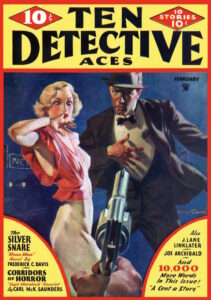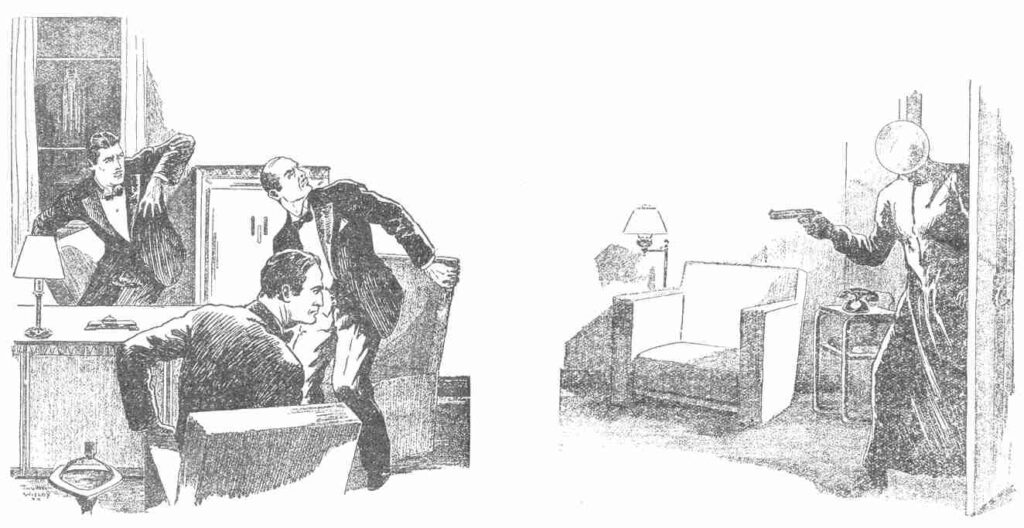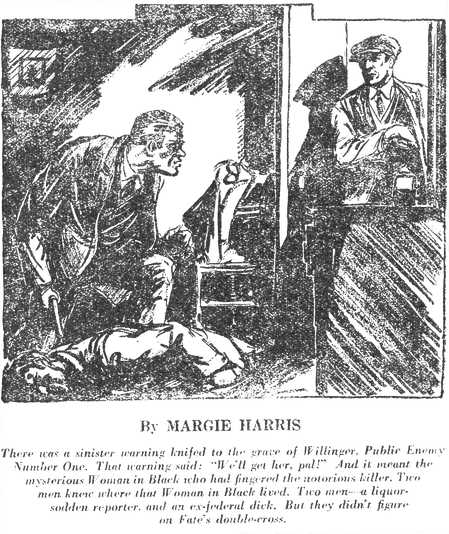This New Year, I made a resolution to live healthy. That resolution includes a commitment to a regular intake of pulpy goodness. This month’s pick-me-up is a 1930s issue of Ten Detective Aces, a magazine started by Harold Hersey before being bought by A. A. Wyn. Its gimmicks were ten stories every issue, all complete, no serials; and a band of repeat detectives who were as weird as the criminals they chased.

The cover by Emery Clarke features a woman in a red dress and a man in formal evening wear being menaced by a gun. The woman in red was a Detective Aces regular; as recognizable as the red border around the cover. And she was always in trouble. Popular Publications had unleashed weird menace on the market in 1934 with Terror Tales, putting women in peril was paying off big. Every pulp publisher imitated Popular’s designs and stories; Popular’s publisher Harry Steeger liked plenty of red and yellow in his covers. There’s enough red and yellow here to make him happy if he was the publisher.
Coming to the contents, the most recognizable series character in Ten Detective Aces was the Moon Man, an implausible masked Robin Hood whose disguise was a fishbowl of one-way glass on his head and black robes from head to toe. The Moon Man was young Steve Thatcher, the son of the police chief and himself a policeman. The constant danger of being unmasked and the resulting disgrace for everyone was a nice way of building up tension in the reader. Times and readers were more gentle and forgiving then, which is why Frederick Davis’ formula worked. Or so I thought until I read the story in this issue, The Silver Snare. I should have known better; there are some good reasons why Fred C. Davis, the creator of the Moon Man, was a million words a year man whose name shows up everywhere in the pulps.

Sneering at past readers credulity, I began reading the story. A mild beginning with a police stakeout to catch an embezzling bank cashier; it rapidly escalates when Thatcher decides to grab the cash to help the needy. In disguise as the Moon Man (the costume allows for rapid changes), he’s nearly caught and escapes after leaving part of his disguise in the laundry. The policeman in charge, Gil Ewen (father of Steve Thatcher’s girlfriend), comes under suspicion of being the Moon Man.
Steve Thatcher is now caught between a rock and a hard place. The only person who can clear Gil is the Moon Man; but the Moon Man’s capture would mean disgrace for everyone and possible death for Steve. In the next four chapters, Steve’s attempts to help put Gil in deeper and deeper trouble and pulled me in. Nice work, Fred Davis. I apologize to you and your readers.
Phantom Finger is a nice little two page firecracker of a story that explodes with the last sentence. The author is Anthony Clemens, better known as Emile C. Tepperman. Recommended.
Married for Murder is also by Tepperman, this time under his own name. Goons kidnap a married man, a member of high-society, and force him to marry a second time at gunpoint. The couple can either pay blackmail, in hundred thousand dollar yearly instalments, or the goons will murder the couple and claim their estate in the second wife’s name. PI Marty Quade is the classic hard-boiled detective, willing to take big risks for pretty women. A cloud of gun smoke cleanses all sins and buries the past before it lifts and reveals the nasty truth. Good if a little hard to swallow.
Margie Harris is the queen of the gangster pulps, an author whose real identity we may never know. Del Sarg, her creation and our hero, is an ex-FBI agent kicked out for missing a chance to capture the famous bank robber DWillinger, who has just been shot dead by the FBI on a tip-off from an informant. Alcoholic police reporter Hap Caswell visits Del; he claims to know the informant’s name and address and wants Del to escort him safely to her location. A passing car machine-guns the woman as she steps out of her building to meet the reporter. Del wants revenge for the dead woman and a way back into the FBI.

As Del Sarg probes the people behind DWillinger’s organization, the conspiracy with DWillinger’s death at its center keeps getting bigger, extending tendrils of death. It’s a conspiracy worthy of Chandler and Marlowe that ends with a shootout over an unearthed grave.
On the surface, this is a thrilling story, well told. Harris’ writing is hard-boiled: “Then they found the big hug-and-love guy dead out on the Hammond prairie. His hat was jammed down over the hole that’d let his brains out—if any.”
This is subversive stuff, though. Margie Harris plays with the idea that the public isn’t told the truth by the FBI. The same FBI that claimed credit before verifying that it was DWillinger they gunned down. Also interesting is the way law enforcement (Del Sarg, the FBI agent in charge) and reporters (the drunk Hap Caswell) form an alliance that only lets the public see information that reflects them in a good light. They exchange favors, each pursuing their goals while nominally pursuing criminals. This issue is turning out to be an enjoyable read.
Alas, the rest of the issue is filler. Hoosier G. T. Fleming-Roberts’ Judgement Ray features an elaborate murder mechanism set by a killer nephew who has to say uncle in the end. California resident J. Lane Linklater’s Death Gag lets us down with a weak premise of instant infatuation turning a fool into a fighter. I was bored by Fire Cheaters(written by Joe Archibald) with its poor imitation of Damon Runyon’s style, hopelessly out of place in the same issue as Margie Harris and Emile Tepperman. In Picked Clean the killer overlooks basic hygiene in his rush to murder. That’s the same basic plot as Judgement Ray and Initials of Doom. Skip them all.
Philip Ketchum aka Carl McK. Saunders disappoints with Corridors of Horror. A Scotland Yard inspector arrives with credentials and tells Inspector John Murdock of Central City that a smooth master criminal called “Soho” Charlie is in town and might be after a famous diamond. Murdock talks hard-boiled but I couldn’t bring myself to care for any of the sketchily drawn characters. The plot and action don’t compensate.
Initials of Doom is a small dose of true crime, this time based on the murder of English immigrant and farmer’s pupil Frank Benwell by Reginald Birchall in Canada c. 1890. How did this show up in a magazine in 1935? You tell me.
Altogether, an excellent package by Harry Widmer, the editor. The Margie Harris story in particular recalls the g(l)ory days of the gangster pulps which had ended a couple of years ago. I rate this issue four stars on a five star scale.
This issue, along with many other pulps, can be read online at the Internet Archive: https://archive.org/details/ten-detective-aces-v-22-n-04-1935-02
PS: If you haven’t already seen it, here’s my review of one of the gangster pulps, whose stories were similar to this.